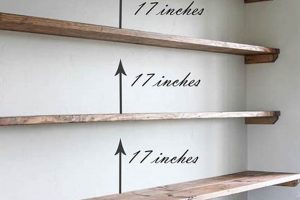A self-assembled display structure for donuts, commonly constructed from materials like wood, pegboard, or cardboard, serves as a visually appealing and accessible presentation method for the popular confection. Such a structure typically features dowels or pegs upon which the donuts are hung, creating a wall-like effect. This method of presentation is often employed at celebratory events or gatherings.
The appeal of crafting such a display lies in its cost-effectiveness, personalization options, and the inherent visual impact it provides. Compared to traditional serving platters, these constructions elevate the presentation, transforming donuts from a simple treat into a decorative element. Furthermore, the act of building it provides a creative outlet and a sense of accomplishment. The structure’s origin can be traced to a desire for unique and memorable event dcor, reflecting a broader trend toward customized celebrations.
The following sections will detail the materials required for construction, step-by-step assembly instructions, customization possibilities, and considerations for ensuring stability and aesthetic appeal of a self-made donut display.
Construction Tips
The following recommendations aim to optimize the structural integrity and visual presentation of a self-constructed donut display.
Tip 1: Material Selection: Employ sturdy materials suitable for the desired size and weight of the donut collection. Pine wood or thick gauge pegboard are recommended for larger displays, while reinforced cardboard may suffice for smaller, lighter versions.
Tip 2: Dowel Rod Placement: Ensure uniform spacing between dowel rods to maintain a balanced aesthetic. Precise measurements are crucial for preventing overcrowding and maximizing visual appeal.
Tip 3: Structural Reinforcement: Implement bracing or supports, particularly for larger structures, to prevent wobbling or collapse. L-brackets or a solid base provide additional stability.
Tip 4: Surface Treatment: Sand all surfaces thoroughly to prevent splinters and ensure a smooth finish. Apply a food-safe sealant or paint to protect the material and enhance its appearance.
Tip 5: Dowel Rod Security: Securely fasten dowel rods to the base material using glue and/or screws to prevent dislodging under the weight of the donuts.
Tip 6: Weight Distribution: Strategically arrange donuts to distribute weight evenly across the structure. Heavier donuts should be placed closer to the base to minimize the risk of tipping.
Tip 7: Transport Considerations: If the structure will be transported, design it to be collapsible or easily disassembled for convenient storage and transport. Secure packaging is essential to prevent damage during transit.
Adherence to these guidelines will contribute to a robust and aesthetically pleasing donut display, suitable for a range of events.
The subsequent section will delve into the creative embellishments that can further personalize the project.
1. Structure
The structural design of a self-assembled donut display directly impacts its capacity, stability, and overall aesthetic. The form dictates the presentation and directly influences its usability and appeal at events.
- Framework Design
The framework establishes the core architecture of the donut display. Options range from simple rectangular boards with affixed dowels to more complex tiered or geometric arrangements. The framework must support the intended weight load and provide sufficient spacing for individual donuts. For instance, a lattice structure may offer greater stability and visual interest but requires more intricate assembly compared to a basic board.
- Dowel Rod Configuration
The arrangement and type of dowel rods used are crucial for both functionality and appearance. Dowels must be securely attached to the framework and spaced appropriately to prevent donuts from touching. Common configurations include horizontal rows, staggered patterns, or even circular arrangements. The diameter of the dowel rods should be suitable to accommodate the donut holes without causing them to tear or slip.
- Base Support
A stable base is essential to prevent the structure from tipping over, particularly when loaded with donuts. Options include a solid platform, sturdy legs, or a weighted support system. The size and design of the base should be proportional to the overall dimensions of the display. A wider base provides greater stability but may also increase the overall footprint.
- Load-Bearing Capacity
The entire structure must be capable of supporting the combined weight of all the donuts it is intended to hold. Material selection, framework design, and joint strength all contribute to the overall load-bearing capacity. Overloading the structure can lead to collapse, resulting in damage to the display and potential loss of the donuts.
In summary, careful consideration of the framework, dowel rod configuration, base support, and load-bearing capacity is paramount to creating a structurally sound and visually appealing self-assembled donut display. The structural integrity directly impacts the usability and success in presenting donuts at any event.
2. Materials
The selection of materials fundamentally determines the structural integrity, aesthetic appeal, and overall cost of a self-assembled donut display. Material choices directly impact the display’s durability, ease of construction, and suitability for various event settings.
- Base Material
The primary component forming the backdrop and structural support of the display dictates its stability and visual presentation. Common options include wood (plywood, pine), foam board, cardboard, and acrylic. Wood offers durability and a rustic aesthetic, while foam board and cardboard provide lightweight and cost-effective alternatives, albeit with reduced structural integrity. Acrylic presents a modern, clean look but may be more expensive and require specialized cutting tools. The selected base material must be capable of supporting the intended weight of the donuts and resisting warping or bending over time.
- Dowel Rods
These cylindrical supports, inserted into the base material, are responsible for holding the donuts. Wood, plastic, or metal dowels are typically employed. Wood dowels offer a natural aesthetic and can be easily painted or stained to match the overall design. Plastic dowels provide a smooth, food-safe surface and are resistant to moisture. Metal dowels offer superior strength but may require additional safety measures to prevent sharp edges. The diameter and length of the dowels must be appropriate to securely hold the donuts without causing damage.
- Adhesives and Fasteners
The secure attachment of dowel rods to the base material is critical for structural integrity. Wood glue, epoxy, screws, and nails are commonly used depending on the materials involved. Wood glue provides a strong bond for wood-to-wood connections, while epoxy is suitable for bonding dissimilar materials. Screws and nails offer mechanical fastening but may require pre-drilling to prevent splitting or cracking. The selected adhesives and fasteners must be capable of withstanding the stress imposed by the weight of the donuts.
- Finishing Materials
The application of paint, stain, sealant, or decorative elements enhances the visual appeal and protects the materials from damage. Paint and stain allow for customization of the color and finish of the display. Sealants provide a protective barrier against moisture and grease. Decorative elements such as glitter, ribbon, or vinyl decals can be added to personalize the display and coordinate with the event theme. Finishing materials should be food-safe and non-toxic to prevent contamination of the donuts.
In essence, the selection of materials profoundly affects the final product. Each component contributes not only to the structural integrity and visual aesthetics but also to the overall cost and ease of assembly. Careful consideration of material properties, availability, and compatibility is paramount for a successful outcome.
3. Customization
In the realm of self-assembled donut displays, customization transcends mere aesthetics, becoming integral to event theming and personal expression. The ability to tailor the structure to specific occasions enhances its visual appeal and strengthens its connection to the overall event narrative.
- Color Palette Coordination
Selection of a color palette that harmonizes with the event’s theme is a fundamental aspect of customization. This involves not only painting or staining the base material but also coordinating the color of the dowel rods and any decorative elements. For example, a wedding-themed donut display might utilize pastel colors, while a corporate event could incorporate the company’s branding colors. The strategic use of color enhances visual cohesion and reinforces the event’s identity.
- Thematic Embellishments
Application of thematic embellishments transforms the display into a cohesive element within the event decor. This may involve incorporating elements such as floral arrangements, banners, or custom signage. For instance, a birthday-themed display could feature balloons and celebratory messages, while a holiday-themed display might incorporate seasonal decorations. Thematic embellishments add depth and character, enhancing the overall visual impact.
- Personalized Signage
Integration of personalized signage allows for the incorporation of specific messages or names, adding a personal touch. This can be achieved through the use of stencils, vinyl decals, or custom-printed banners. For example, a wedding reception might feature signage displaying the names of the newlyweds, while a corporate event could showcase the company logo. Personalized signage enhances the sense of occasion and creates a memorable experience.
- Material Texture and Finish
Consideration of material texture and finish adds another layer of customization. The choice between a smooth or textured surface, matte or glossy finish, can significantly impact the display’s aesthetic. For instance, a rustic-themed event might benefit from a distressed wood finish, while a modern event could utilize a sleek, glossy acrylic surface. The deliberate selection of material texture and finish contributes to the overall visual harmony and reinforces the event’s style.
These facets of customization converge to create a cohesive and impactful self-assembled donut display. By carefully considering color coordination, thematic embellishments, personalized signage, and material texture, it becomes a bespoke creation that enhances the visual appeal and personal significance of the event. The ability to personalize every element contributes to a unique and memorable experience for all attendees.
4. Stability
The structural integrity of a self-assembled donut display is paramount, directly influencing its safety, functionality, and visual presentation. Compromised stability can lead to collapse, resulting in damage to the display and potential loss of the edible items it presents. Therefore, careful consideration must be given to various factors that contribute to the overall robustness of the structure.
- Base Support and Weight Distribution
The foundation upon which the display rests is critical for maintaining equilibrium. A wide, solid base constructed from a durable material (e.g., thick plywood, reinforced metal) provides a stable platform. Even weight distribution is equally important; positioning heavier donuts closer to the base reduces the risk of tipping. An inadequate base or uneven weight distribution can significantly compromise the display’s stability, particularly when fully loaded.
- Material Selection and Load Capacity
The choice of materials directly affects the display’s ability to withstand the applied load. Lightweight materials like foam board or thin cardboard may be suitable for smaller displays with fewer donuts, but larger structures require stronger materials such as solid wood or acrylic. The load capacity of each component (base, dowels, supporting frame) must be carefully calculated to ensure it exceeds the anticipated weight of the donuts. Utilizing materials that are not appropriately rated for the intended load can lead to structural failure.
- Joint Strength and Fastening Methods
The connections between individual components are often the weakest points in a self-assembled structure. Secure and reliable fastening methods are essential to prevent separation or weakening under stress. Wood glue, screws, bolts, or dowels can be employed, depending on the materials being joined. Reinforcing joints with metal brackets or corner braces can further enhance their strength. Improperly joined components compromise the overall stability, making the display susceptible to collapse.
- Environmental Factors and External Forces
The environment in which the display is used can also affect its stability. Uneven surfaces, wind gusts (if used outdoors), or accidental bumps can all exert external forces that disrupt its equilibrium. Positioning the display on a level surface and providing additional support or bracing can mitigate these risks. Anticipating potential environmental factors and implementing appropriate safeguards is crucial for maintaining stability and preventing accidents.
In conclusion, stability is not merely a desirable attribute but a fundamental requirement for a functional and safe self-assembled donut display. Attention to base support, material selection, joint strength, and environmental factors is essential to ensure that the structure can reliably perform its intended function without posing a risk to property or individuals. A stable display not only enhances the presentation of the donuts but also provides peace of mind to the event organizer and attendees.
5. Presentation
Presentation is intrinsic to the value and impact of a self-assembled donut display. The structure itself functions primarily as a vehicle for elevated visual merchandising, transforming the perception of the donuts from commonplace treats to artfully arranged elements of event decor. Cause and effect are directly linked: a well-designed presentation enhances perceived value and appeal, thereby increasing engagement and enjoyment. Without careful consideration of presentation, the structure, regardless of its structural integrity, fails to achieve its full potential.
Consider a wedding reception where a meticulously crafted display, adorned with coordinating colors and personalized signage, presents donuts as an integral part of the celebratory atmosphere. Conversely, a hastily assembled structure with haphazardly arranged donuts detracts from the event’s overall aesthetic, undermining the intended elegance. Another example resides in corporate events, where a display mirroring the company’s branding reinforces its identity and creates a cohesive visual message. The practical significance lies in the ability to influence perception and enhance the overall event experience through conscious design choices.
In summary, presentation is not merely an ancillary consideration but a fundamental component of the self-assembled donut display concept. It dictates the structure’s capacity to engage, delight, and contribute meaningfully to the event’s narrative. The challenge lies in achieving a balance between structural soundness, aesthetic appeal, and thematic relevance, ensuring the display functions as both a functional and visually compelling element. By prioritizing presentation, constructors can elevate the donut display from a simple structure to a focal point of event decor, enhancing the overall sensory experience.
6. Portability
Portability represents a crucial design consideration for self-assembled donut displays, particularly when intended for use across multiple locations or events. The ease with which the structure can be transported and reassembled directly impacts its practicality and overall value proposition. A donut display, however aesthetically pleasing, loses significant utility if it proves unwieldy or difficult to move. In essence, cause and effect dictate that limitations in portability lead to restricted usage and diminished return on investment.
The design phase must integrate strategies for efficient transport, such as modular construction, collapsible components, and lightweight materials. A multi-tiered wooden display, for example, might incorporate detachable levels and a foldable base to minimize its footprint during transit. Protective cases or custom-fitted boxes further contribute to portability by safeguarding the display against damage during transportation. Consider a small business owner who utilizes a portable donut display at various farmers’ markets. A lightweight, easily disassembled structure enables them to set up and dismantle their booth quickly and efficiently, maximizing their sales opportunities. Conversely, a bulky, non-portable display would impede their operations, limiting their ability to participate in multiple events.
Therefore, portability stands as a pivotal factor influencing the practical application of self-assembled donut displays. Balancing structural integrity with ease of transport presents a design challenge, demanding innovative solutions and a clear understanding of the intended usage scenarios. The ultimate goal is to create a donut display that is both visually appealing and conveniently mobile, thereby maximizing its versatility and utility across diverse event settings. Neglecting this aspect compromises the overall value and restricts the opportunities for its deployment, thus failing to capitalize on the full potential of the concept.
Frequently Asked Questions
The following questions address common inquiries and misconceptions regarding the design, construction, and utilization of self-assembled donut displays.
Question 1: What are the primary factors influencing the structural stability?
Structural stability is contingent upon base support, material selection, joint strength, and environmental considerations. A wide, solid base, durable materials, secure fastening methods, and awareness of potential external forces are essential for preventing collapse.
Question 2: What materials are most suitable for constructing a durable donut display?
Wood (plywood, pine), acrylic, and reinforced metal are recommended for robust structures. The specific material will depend on the desired aesthetic, weight-bearing requirements, and budget constraints.
Question 3: How can the display be customized to match a specific event theme?
Customization can be achieved through color palette coordination, thematic embellishments, personalized signage, and careful selection of material textures and finishes. These elements should align with the event’s overall design and atmosphere.
Question 4: What considerations are important for transporting a self-assembled display?
Portability requires a design that incorporates modular construction, collapsible components, and lightweight materials. Protective cases or custom-fitted boxes are recommended for safeguarding the display during transportation.
Question 5: How is proper hygiene maintained when using a self-assembled donut display?
All materials that come into direct contact with food should be food-safe and easily sanitized. Regular cleaning of the display is essential to prevent contamination and maintain a hygienic presentation.
Question 6: What are the key design elements that contribute to an effective presentation?
Effective presentation involves careful arrangement of the donuts, strategic use of lighting, and integration of complementary decorative elements. The goal is to create a visually appealing and enticing display that enhances the perceived value of the donuts.
In summary, a successful self-assembled donut display requires meticulous planning, careful material selection, and a keen understanding of structural principles and aesthetic considerations. Attention to detail is paramount for achieving a functional, visually appealing, and safe structure.
The following section provides a concise summary of the preceding discussion.
Conclusion
The preceding analysis has elucidated the multifaceted considerations inherent in the conception, construction, and implementation of the “diy donut wall.” From structural stability and material selection to aesthetic customization and logistical portability, each element contributes to the overall efficacy of the display. The successful execution demands a synthesis of practical engineering principles and design sensibilities. It is important to note that adherence to food safety guidelines and hygienic practices is paramount when utilizing these structures for edible presentations.
The self-assembled donut display, when executed effectively, serves as a compelling visual centerpiece for various events. It is imperative that designers and builders approach this endeavor with meticulous planning and attention to detail, recognizing that the final product reflects not only their craftsmanship but also the intended impression upon event attendees. The continued evolution of designs and materials promises further innovation in this specialized area of event presentation, enhancing both aesthetic appeal and functional utility.







